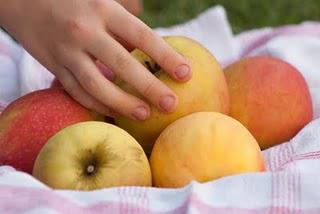
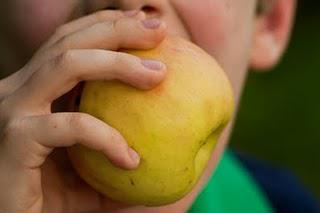 Kari over at "Chef and Steward" has set a Mystery Basket challenge. It doesn't sound too hard - simply get three fresh items per day and cook with them.
Kari over at "Chef and Steward" has set a Mystery Basket challenge. It doesn't sound too hard - simply get three fresh items per day and cook with them. But what is fresh? I decided to set myself an extra challenge, and in order to benefit my family with the extra taste, vitamins, and hopefully tax the environment just a smidge less, I have decided to buy items that are also in season. And this is where the conundrum starts.
When you live in the middle of the world AND in the desert, the whole concepts of "fresh" and "seasonal" produce is practically laughable. We have a smattering of farms in the vicinity, and they produce the only the following in great quantity:
- Tomatoes, capsicum and beans (in chilled greenhouses)
- dates, zucchini and roka (aragula)
- Camel or cows milk, Laban and labaneh (cows milk yoghurt products)
- Battery eggs and scrawny chickens (nigh-on impossible to buy one over 1200g)
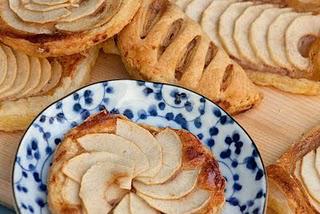 But the benefit of living here is that imports are everywhere. Greenhouse effect be damned - I want an apple! But where to get it from? When I go to the store, I have a choice of US, New Zealand, Chinese and French apples. Now - apples are an Autumn fruit, so that means the NZ ones are out - it's just gone spring down south. The US ones were these waxy perfect looking green and red ones. But I don't trust apples that look like that - it's just not natural. The Chinese ones were fuji apples - super sweet and crisp, but no good for cooking. The French ones? Pink Ladies - the most fragrant of them all. I used them to make some super easy apple pastries (click on the link for the recipe).
But the benefit of living here is that imports are everywhere. Greenhouse effect be damned - I want an apple! But where to get it from? When I go to the store, I have a choice of US, New Zealand, Chinese and French apples. Now - apples are an Autumn fruit, so that means the NZ ones are out - it's just gone spring down south. The US ones were these waxy perfect looking green and red ones. But I don't trust apples that look like that - it's just not natural. The Chinese ones were fuji apples - super sweet and crisp, but no good for cooking. The French ones? Pink Ladies - the most fragrant of them all. I used them to make some super easy apple pastries (click on the link for the recipe).So back to seasons...
Here's a list of the basics - eat these in their seasons, and you will probably be eating fresh:
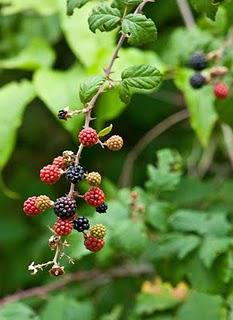 Summer:
Summer:most berries, cherries and many other stone fruit and melons. Corn, tomatoes, beans, zucchini, cucumber, many leafy greens (lettuce, spinach, watercress etc), fennel and celery, nightshades such as capsicum, potatoes and eggplant, beans and peas, and many root veg (carrots, beet, radish and sweet potatoes). Asparagus may still be around for the first month. Dates start in late summer.
Autumn:
All the slower ripening fruits - grapes, apples, figs, pears, dates etc, and my favourite, pomegranites. Many of the leafy veg are still in, including kale and rhubarb, as are the above root veggies and some other later ones such as turnips, parsnip, onions and ginger. Cabbage, broccoli and it's cousin cauliflower come in early, brussel sprouts, and just in time for Halloween in October (or April in the Southern Hemisphere), all the marrows - pumpkin, butternut squash and melons etc. And let's not forget mushrooms and truffles - coming in late autumn and early winter.
Winter:
Think about the Christmas roast: root veggies are still around, along with brussel sprouts and leeks for warming soups. Apart from that, everything's in pretty low supply, except for the most useful of fruits, citrus.
Spring:
The time of rebirth - think green. Almost anything sweet and snappy is in - leafy greens, asparagus, herbs, chicory, watercress, and early sweet baby peas. Hurrah, avocados are back, and all those sweet tropical fruits - mango, pineapple, and lychees coming a little later.
I'd like to put meat in a different category, because this is subjective. It's rare to get meat that is both at its most tender and most flavoursome, and people usually go one way or the other. Lamb, for example - it's tender in Summer, but tasty in Autumn, possibly more so in Winter, but tough in Summer. However, just to confuse everything, there are generally two birthing seasons - both Spring and Autumn (less in Autumn), and so occasionally you will come across a lovely piece of lamb in Summer, and a terrible one in Winter. This is why it's best to be friends with your butcher. Beef is an aged meat, as is pork, so is pretty good year-round, but veal is like lamb - best in Winter, but Milk-fed is earlier, and again there is a second season.
When it comes to seafood, there is a general rule - don't eat when they are spawning (making babies), because the flesh always tastes different. Generally, bivalves (oysters, clams, mussels, etc. excepting sea scallops) and crabs are better in winter, and shrimp and prawns (and sea scallops/st jacques) are the summer choice. Fish is usually better in the warmer seasons, with exception to some such as swordfish and sea bass. If you must eat Hamour in the UAE, don't do it in Spring, because that's when it spawns, and it's already over-fished.
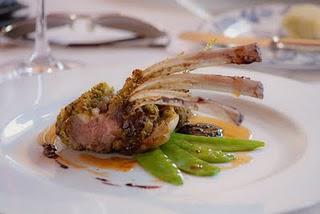 You know how birds fly south for the winter? That's because Winter is precisely the time everybody wants to eat them, particularly game birds.
You know how birds fly south for the winter? That's because Winter is precisely the time everybody wants to eat them, particularly game birds.And don't forget that in Dubai, we get both Southern and Northern Hemisphere foods. For the life if me, I could not find any lamb from the North, so I took a risk with the Aussie stuff and it turned out to be perfect. Must have been an autumn drop.
Did I mention it's really time for me to go vegetarian?
Maybe tomorrow...
----------------------------------
Kari - just so you know, I also made some Parmesan-crusted lamb cutlets and sauteed snow peas with a mustard and shallot dressing on day one. Day two I made banana pancakes for an afternoon snack, and chicken and cauliflower pie with a salad of baby spinach, sun-dried tomatoes and pine nuts. Tomorrow I'm thinking a ginger and sweet potato soup, and maybe I'll attack a pomegranate if I can find a pretty one. Cooking fresh every day is easy - blogging fresh every day? Another thing entirely.
Leave me a comment and make my day...
